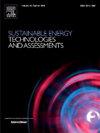Comprehensive performance analysis of semitransparent CdTe PV windows in static and dynamic facades: A real ship case study
IF 7.1
2区 工程技术
Q1 ENERGY & FUELS
Sustainable Energy Technologies and Assessments
Pub Date : 2025-04-01
DOI:10.1016/j.seta.2025.104297
引用次数: 0
Abstract
PV windows are mostly installed on fixed facades of static buildings with limitations such as partial shading and non-uniformity power generation. Ships, as special man-made construction, their orientation and speed are changeable under sailing condition. A significant portion of ship’s energy consumption is dedicated to maintaining the comfort of cabin environment. To expand the PV windows application scenarios and reduce the cabin energy consumption, this paper proposes an innovative application of CdTe PV windows in ship-based moving condition. The dynamic variations in solar irradiation received angle depend on different energy converting orientations of PV window since the ship movements. Thus, PV windows can avoid non-uniform irradiation and partial shading, leading to better energy harvesting efficiency in solar energy capture when PV windows are connected in parallel. The comprehensive performance of PV windows is compared under two conditions: a mooring condition with a northwest-facing bow and a sailing condition with closed sailing routes. The results indicate that under sailing condition, the average power generation efficiency of PV windows increased by 65.05% and heat transfer was reduced by 57.47%. The energy generation by PV windows can meet 100% of energy demand for ship cabin air conditioning and lighting under sailing condition.
静态和动态外立面半透明CdTe光伏窗的综合性能分析:实船案例研究
光伏窗多安装在静态建筑的固定立面上,存在部分遮阳、发电不均匀等局限性。船舶作为一种特殊的人造结构,其航向和航速在航行条件下是可变的。船舶能源消耗的很大一部分是用于保持客舱环境的舒适性。为了拓展光伏窗的应用场景,降低客舱能耗,本文提出了一种创新的CdTe光伏窗在船舶移动工况下的应用。船舶运动后太阳辐照接收角的动态变化取决于PV窗能量转换方向的不同。因此,光伏窗可以避免不均匀照射和部分遮阳,当光伏窗并联时,太阳能捕获的能量收集效率更高。对比了船首朝西北系泊和航线封闭航行两种工况下PV窗的综合性能。结果表明,在航行工况下,光伏窗的平均发电效率提高了65.05%,传热减少了57.47%。光伏窗发电可100%满足航行工况下船舶舱室空调和照明的能源需求。
本文章由计算机程序翻译,如有差异,请以英文原文为准。
求助全文
约1分钟内获得全文
求助全文
来源期刊

Sustainable Energy Technologies and Assessments
Energy-Renewable Energy, Sustainability and the Environment
CiteScore
12.70
自引率
12.50%
发文量
1091
期刊介绍:
Encouraging a transition to a sustainable energy future is imperative for our world. Technologies that enable this shift in various sectors like transportation, heating, and power systems are of utmost importance. Sustainable Energy Technologies and Assessments welcomes papers focusing on a range of aspects and levels of technological advancements in energy generation and utilization. The aim is to reduce the negative environmental impact associated with energy production and consumption, spanning from laboratory experiments to real-world applications in the commercial sector.
 求助内容:
求助内容: 应助结果提醒方式:
应助结果提醒方式:


